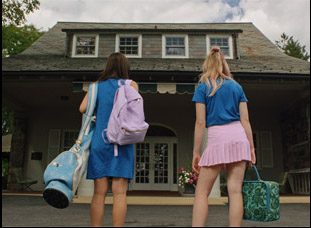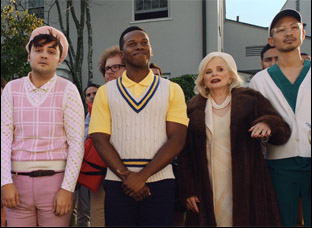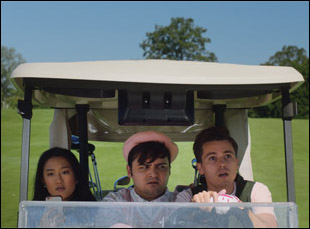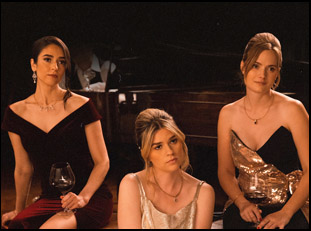“Labels aren’t just for show, they show what’s inside,” a superior of Tina and Elsa Cartwright (played by real-life sisters Fiona and Sophia Robert, respectively) tells the two as they start work at the Butlerbrick Golf Course in “The Country Club” as they set about itemizing stock in the store on-site. It’s an entry-level job albeit a coveted one, or at least it once was when Butlerbrick was popular amongst the jet set, though now the Cartwrights are expected to bring the prestige when they’re said to be connected to the Connecticut Cartwrights, whose wealth is so vast it’s left in largely unspoken terms, so much so that when Tina and Elsa actually belong to another family tree altogether, it’s relatively easy to hide their true identity, though it won’t be pretty should it ever be revealed.
The links become a playground for the Robert Sisters, who oversee all varieties of comedic chaos during an invitational that Butlerbrick has trouble finding people to attend leaving the Cartwrights to ultimately break out their own clubs, and “The Country Club” becomes an auspicious debut for the pair of multihyphenates that look to change the game in a variety of ways. With Fiona having accrued an insider’s knowledge of the inner workings of a set when she worked on shows such as “Younger” as an actress and Sophia’s training to become a ballerina instilled a sense of discipline she’s come to lean on as a director, “The Country Club” doesn’t only mark the two’s first time behind the camera — in addition to their work in front of it — but the start of a production company that has already completed a second feature “A View of the World From Fifth Avenue,” which premiered this past week at the Bentonville Film Festival.
Setting their films in environments where legacies hold a lot of weight, the two are making a name for themselves when stylistically “The Country Club,” with its ribald humor (going so far as to credit its fart sounds to Steve Higgins, father of the film’s star John Higgins of Please Don’t Destroy fame) couldn’t be more different than “A View of the World,” a comedy of manners set in Manhattan where a young socialite named Annabel (Fiona Robert) finds herself living out the same dilemma that her famous father who recently died of a drug overdose did as she feels the pull of joining a hardscrabble creative community of artists when she begins to date a photographer (Paul Karmiryan) who takes pictures of the debutante balls she and her well-heeled circle of friends attend. Both films don’t only consider how previous generations have shaped the current one, but actively stitch such ideas into the fabric of the films that may wear their influences on their sleeve yet savvily put their own spin on things.
In the midst of a busy June for the pair with “The Country Club” now on VOD after a successful festival run and “A View of the World from Fifth Avenue” just starting to follow in its footsteps on the circuit, they graciously took the time to talk about getting things up and running with Robert Sisters Productions, making the most out of the limited budgets they have to work with and finding generosity amongst other artists as they establish themselves.

Fiona Robert: It’s really reassuring to know that we are on the right track doing what we love.
Sophia Robert: Yeah, we filmed “Country Club” pre-pandemic and then “View of the World” when people had to wear masks on set, so it feels like such a release for it to be summer, it’s June, and the movie is out. Getting to have people come to the theater and see it feels like a return to normalcy, and for me, it’s like a sigh of relief.
How did you two decide to join forces and start a production company?
Sophia Robert: We both studied at NYU Tisch for acting, and we wanted to make our own work.
Fiona Robert: Yeah, I had been a part of an improv team at NYU where we did fully improvised plays for 90 minutes [with] 20-minute rehearsals [beforehand] and one of the 20-minute rehearsals was a scene from “Country Club.” I had not done my homework for a screenwriting class I had the next day, so I asked my friends, “Can I use this rehearsal that we’re doing as my script?” And they were like, “Sure.” So I brought in 10 pages of “Country Club” that we had improvised, and everyone in the class really liked it and they were like, “Are you going to bring in more ‘Country Club’ next week?” And I was like, “Okay.” [laughs] So I started writing it for this class, and then I got Sophie involved because we were living together in New York and after we had the script, I was like, “Let’s make it.” That’s why we formed the company, because we just needed an LLC name to make the movie.

Fiona Robert: I don’t think it’s a coincidence. I’m interested in Sophie’s perspective, but from mine, I’m very interested in how people deal with wealth and class, especially living in New York. It’s such a melting pot and we knew people from every walk of life and seeing it right next to each other was very interesting. Both “Country Club” and “A View of the World” have themes of coming together between different backgrounds and different socioeconomic status and we want to promote friendship and people coming together, not being in the vein of something like “Succession” where everybody is stepping on each other, but rather how do we teach people to lean on each other and to give and to be friends.
Sophia Robert: “The Country Club” and New York are both microcosms for what we’re dealing with in society today, and Fiona and I love an ensemble and it’s interesting for us to explore group dynamics within a group of friends. I like action movies, but I don’t need violence or all that as a driver for my plot. Relationships are the most interesting to me and in both of our films, we’re using a small group of friends as a microcosm for larger problems that we’re dealing with in society. Even our next film that we’re going to write, we’ll use a group of friends as a microcosm and [how that] defines people’s behavior and their feeling of status or belonging in their group.
It looks like you’ve built a bit of a company both behind and in front of the camera with these two films. Has that been exciting to develop?
Sophia Robert: Yeah, one of the most important things we learned is to build your team and at Bentonville, we had Josh Pate, the creator of “Outer Banks” who came to talk to us and he said, you will find people on your set that you love working with and you’ll hire again and again. Shout out to Elaine Hendrix. She’s been in both of our films and she’s been very collaborative and supportive of us as young filmmakers.
Fiona Robert: Yeah, we love “Outer Banks,” and Josh works with his brother, so it was really inspiring to hear him talk, and one of the things he was saying that really resonated with us was how there are actors that we will hire for all of our movies and the same with crew. You see a lot of big directors who do that and you think, “Oh, they just like working with their friends,” but when you’re making a movie, which is such a huge undertaking, it helps to have people that you know are going to be positive on set and fun. That makes a big difference.

Fiona Robert: Yeah, I basically called 40 country clubs throughout New York state, and every single one on Long Island was like, “This is a private club, how dare you.” [laughs] I even called some in L.A. and then I found one upstate [where] we found out later the manager was leaving, and that might’ve had something to do with it where he was like, “You know what? If this goes horribly wrong, I’m not working here next year.” So we said, ‘This is our budget. Can you make it work?’ And he said, “Sure,” and then I went back to my line producer and I [said], “I got the club for this amount.” And [our line producer said], “Yeah, you can’t afford that. You need to call him back and ask for a 90% discount on what he already agreed to.” So I call him back and he was super nice.
They were so helpful too, because in “Country Club,” a third of the movie takes place in the rain and the special effects guy was like, “Where are we going to get all this water?” But we realized the golf course has this amazing irrigation, and the guy who runs the golf course was like, “Yeah, you can use our water, no problem.” We’re from the Midwest and I feel like, when you go and talk to people in Westchester or smaller towns outside of New York and L.A., people tend to be a little bit more excited by the idea of a movie, so they’re cool.
What was it actually like to film with that much precipitation?
Fiona Robert: Well, I think you make mistakes on your first movie and they say you’re not supposed to work with children, animals, and the rain and we did two out of three of those things because we just didn’t know any better. But it worked, and it’s funny because when we were filming, we didn’t have a big monitor [to watch playback] because we were low budget, but our DP was like, “I don’t think there’s enough rain.” And then later when we saw it on the big screen, we’re like, “Oh, it looks like they’re in a hurricane.”
Sophia Robert: Fewer special effects saves money in indie film and is easier, but we were all pretty wet the second half of the film. We had a fun time.

Sophia Robert: It was pretty wild. Sometimes we were in the same place and sometimes we had company moves. We had a great locations team that got us permits for our trucks. But for the main locations, Fiona and I went around to [places such as] National Arts Club, who allow filming, and the Ukrainian Institute was another main location — if you’ve ever seen Cruel Intentions, they filmed there — and those locations were incredibly supportive. Shooting in the park was really bad for sound, but we made it work.
Fiona Robert: Sophia and I had actually made a list of all the places in New York we wanted to put on screen that were favorites of ours, which made it easier because we started talking to those people way in advance of even pre-production, [asking] “Would it be okay if we did a scene out here?” The scene at the Comedy Cellar, for example, they gave us 15 minutes before their show opened to shoot that, and we were like, “Whatever, we’ll take it.” So we scrounged and went with what was affordable. If we had a cafe in mind and they were like, “It’s going to be $10,000 a day,” we were like, “Okay. We’ll find one that can do it for $1,000.” But the cool thing about shooting in New York that I learned a long time ago is that you could be doing anything on the street and New Yorkers won’t even look up from their phone, so that actually makes it easy because you can like be shooting a full breakup scene in Central Park and people are just walking by and they don’t care.
Did that make it easier to do that night shoot where Fiona is walking through the street in a costume? That seemed like it could be a wild night of filming.
Fiona Robert: I had the brilliant idea that we should shoot it on Halloween to save on extras [because I thought] everyone will already be in costumes. But then I forgot that that means it’s going to be so loud outside because it’s Halloween. But nobody cared, truly. We had a couple of background actors with us who were in costume to make it look like Halloween, and then when we got down into the Village, there were people in Halloween costumes and we just had them sign releases and they were like, “Cool, I’m in a movie.” So that went well. Then we had a great sound mixer and editor, Lucien [Palmer] at Toolshed Audio Post, and he cleaned that scene up and made it sound really good.
It also seems like a stamp of approval of sorts that Whit Stillman and Carolyn Farina show up. How did the “Metropolitan” reunion come about?
Sophia Robert: They were great. We’ve always been a big fan of “Metropolitan” and “Last Days of Disco,” Whit’s classic New York movies, so we wrote to him and said we wanted to write a film in conversation with “Metropolitan,” looking at the same scene of debutante balls 30 years later — of course, now people do more charity events as opposed to deb balls in the city, but he was very supportive and fun.
Fiona Robert: And he suggested that Carolyn might want to be in the film too, and we [thought], “Of course, that would be amazing,” and we had this scene already written and we thought these are the two perfect characters for them to play because they’re a bit old guard as parents. And I think Annabelle [their daughter] is looking to the new, to the future, so it’s interesting to have those two people in our new film, which hopefully carries that conversation about New York and the philanthropy scene and the Upper East Side forward.
I really like that you called it a conversation because in both these films, it seems like an opportunity to revisit stories from the past and put your own twist on them. Has it been fun to investigate genres like that?
Sophia Robert: Yeah, it’s easy sometimes as an actor to get stuck in one genre and as long as we’re making our way in the industry, we’re trying to explore different things.
Fiona Robert: Yeah, and hopefully Sophia and I will develop our own style as filmmakers that will become clearer, but I don’t think that any director is an island. When I look at Wes Anderson movies, I see a lot of the French New Wave [with the] fastidious mail going through pipes or little jokes back and forth and I see a lot of Truffaut and Godard, and when I watch “Reservoir Dogs,” I see early Scorsese, so I think every director learns from watching the greats. And it’s been cool to have Whit Stillman’s support in making a film that yes, I would say it’s in conversation [with “Metropolitan”] but I do hope that Sophie and I continue to develop our own recognizable style.
Fiona Robert: One of the other cool things that we’ve noticed about collaborating with some of our favorite artists is a lot of them are very keen to help young directors and filmmakers. For example, I don’t know if you noticed this, but in “Country Club” there are three songs that were actually written and performed by Gus Van Sant. He made an album of golf songs when he was 30, which is so random, and we also just wrote to him and said, “Can we use these songs in the movie?” And he was like, “Yes, of course.” And that’s really cool and very validating, not just having the movies come out, but also having these legacy filmmakers that we really admire letting us explore and collaborate.
“The Country Club” is now available to watch on Amazon, AppleTV, Vudu and Google Play. “A View of the World from Fifth Avenue” does not yet have U.S. distribution.




